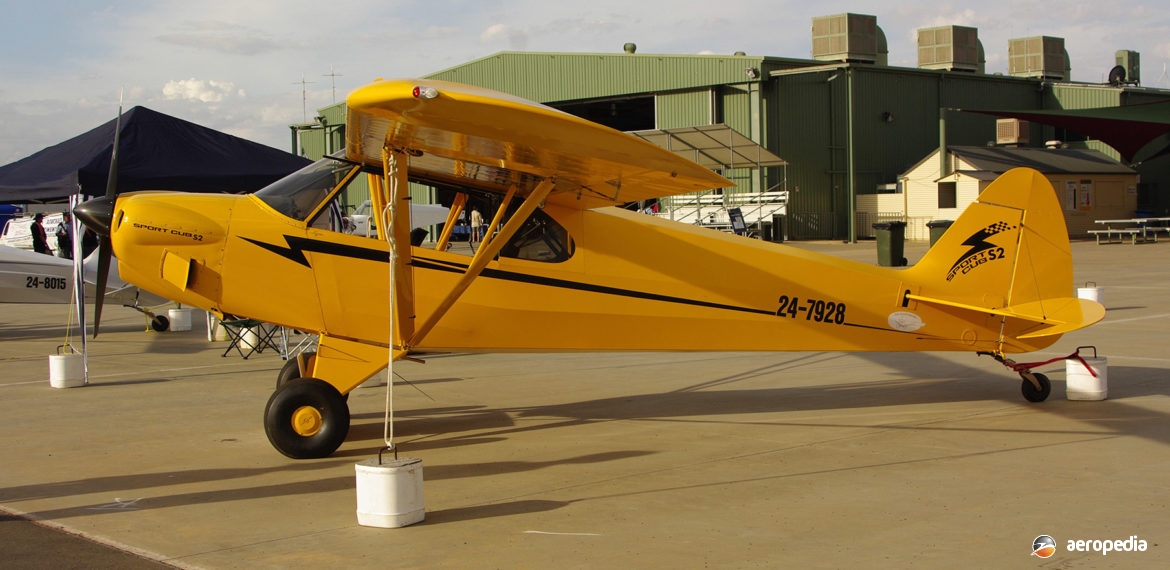Photograph:
Cubcrafters CC11-100 Sport Cub S2 24-7928 (c/n CC11-00083 – ex N7650C) at Temora, NSW in June 2012 (David C Eyre)
Country of origin:
United States of America
Description:
Two-seat light sport aircraft
Power Plant:
[CC11-100]
One 75 kw (100 hp) Continental O-200 four-cylinder horizontally-opposed air-cooled engine
Specifications:
- Wingspan: 10.63 m (34 ft 9 in)
- Length: 7.1 m (23 ft 3 in)
- Height: 2.56 m (8 ft 4 in)
- Wing area: 16.35 m² (176 sq ft)
- Max speed at sea level: 196 km/h (122 mph)
- Cruising speed: 169 km/h (105 mph)
- Service ceiling: 4,267 m (14,000 ft)
- Rate of climb at sea level: 244 m/min (800 ft/min)
- Take-off roll: 76 m (250 ft)
- Take-off distance over 15 m (50 ft) obstacle: 290 m (950 ft)
- Landing roll: 61 m (200 ft)
- Landing distance over 15 m (50 ft) obstacle: 305 m (1,000 ft)
- Endurance with single tank: 2.5 hrs
- Endurance with two tanks: 5 hrs
- Max range with single tank: 362 km (225 miles)
- Max range with two tanks: 724 km (450 miles)
- Empty weight: 374 kg (825 lb)
- Max useful load: 225 kg (495 lb)
- Max payload weight with full fuel: 159 kg (351 lb)
- Loaded weight [wheels]: 599 kg (1,320 lb)
- Loaded weight [floats]: 649 kg (1,430 lb)
History:
The CubCrafters CC11-100 was introduced to the Light Sport Aircraft (LSA) market in the United States to meet a requirement for a lower-powered variant of its range and was an entirely new aeroplane designed from the ground up, making extensive use of modern avionics, design techniques and composites, including carbon fibre, which was not available when the Piper Super Cub was first designed. In order to streamline the introduction of the new design, testing requirements were relaxed by LSA Regulations and, whereas Top Cub was certificated under FAR 23 Amendment 55 in December 2004, less stringent testing was required.
The prototype Sport Cub was flown from Yakima in Washington to Oshkosh in Wisconsin in July 2005 for the annual Experimental Aircraft Associaton (EAA) Air Venture event, the first production aircraft being completed in April 2006. Testing found that each wing on the Sport Cub weighed 20 kg (44 lb) but demonstrated an ability to support nearly 1,996 kg (4,400 lb). The only steel fittings in the wings were the nuts, bolts and some wires, all other fittings being machined aluminium. The wing struts were extruded aluminium and the ailerons and flaps were aluminium skinned and were interchangeable from left to right. Flaps were an option and standard fuel capacity was 45 litres (17.5 Imp gals) in a tank in the left wing but an optional tank of similar size could be installed in the right wing.
Engine was the 75 kw (100 hp) Continental O-200 driving either a wood Sensenich propeller, or a metal McCauley unit. The undercarriage was the standard Super Cub style tailwheel with bungee suspension, Grove wheels and brakes, but Alaskan Bushwheels could be fitted as could floats.
Sport Cub S2s registered with Recreational Aviation Australia (RAA) have included 24-5139 (c/n CC11-00040 – ex N347SC) registered on 21 August 2007 and 24-5140 (c/n CC11-00044 – ex N466SC) also registered on 21 August 2007.

